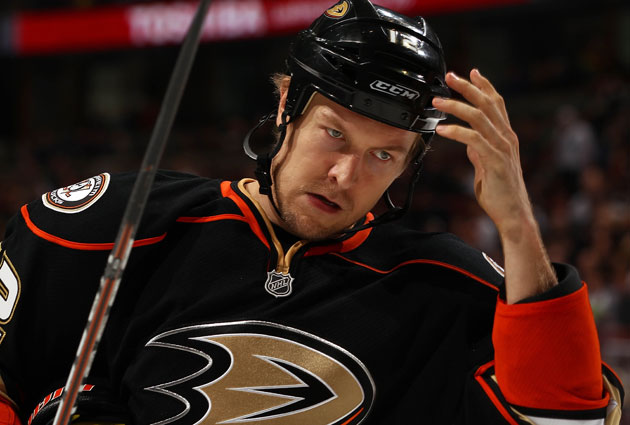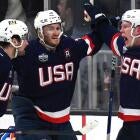How much ground has KHL made on NHL? Hint: Not a lot
The NHL and KHL extended their agreement to not poach under-contract players from the other side earlier this month, which begs the question: Is the KHL becoming an actual competitor for the NHL?
 |
| It's a bit telling that Finn Niklas Hagman was the biggest NHL name to go to the KHL this summer. (Getty Images) |
Earlier this month the NHL and KHL extended their entente cordiale that says no team from either will attempt to sign a player under contract with a team in another league. Essentially, free agency is the same in both North America and Europe.
If we're being honest, though, this is pretty much a one-way street we're talking about. The fear doesn't so much exist in the KHL as much as it does in the NHL of one side taking the other's talent. It's designed to keep some of the rich and free-spending teams in Russia from trying to poach North American players who are under contract in the NHL.
Besides the individual teams' grievances against a player they have a contract with moving to another league not being fond of that idea, it's also a bit symbolic of a minor fear of the KHL rising in stature and taking some of the NHL's nearly monopolized market share of professional hockey.
However the fact that the agreement was necessary in the first place underscores how the KHL has at least been able to make a dent in the NHL's armor. The principal example at play here is of course Alexander Radulov, who was stuck in contract limbo between the two leagues, hence his ability to come back to North America and finish last season with the Predators despite playing in the KHL just a few weeks before.
This year's free agency has seen a few players -- and not just Russian/Eastern European-born players either -- choosing the KHL. To be absolutely fair, except for Radulov none of the players that left for the KHL were in demand by NHL teams. The list of headliners that signed in the KHL this summer after being in North America includes Niklas Hagman, Mark Flood, Nikita Filatov, Sami Lepisto and Erik Christensen. Not exactly an NHL All-Star group there.
Still, these are players who might have had a chance to sign a two-way contract and possibly make an NHL team but most likely they would have been in the AHL. Why make the move to go play in Russia instead? Fedor Fedin of the Capitals blog Russian Machine Never Breaks explained.
"It's all about the money. According to CapGeek, 'highly-paid' AHLer earns $200k or so per year," Fedin said. "KHL is a chance for these guys to earn more, much more even when mediocre. I don't have the numbers, but it's pretty clear.
"Though every North American player is just as big a risk as a Russian for an NHL team, and probably even bigger. There are a lot of failed experiments [Chris Bourque, Jim Montgomery, etc.] and the risk sometimes seems too large for a team that has to use a 'foreign player' spot for that guy [you can have up to 5 foreigners on your team]."
That is why the KHL is still light years behind the NHL in terms of attracting the world's best. The league stands a fighter's chance when you are talking about Russian players because they know the country and are comfortable at home but when you take players from elsewhere, particularly North America, you never can be sure what you're going to get. It's a whole new world.
In all honesty, besides the prestige of playing in North America and vying for the Stanley Cup, something just about every Canadian boy dreams of and many in the States too, there are a lot of obstacles.
For instance, Russian goalie Ilya Bryzgalov talked to Sovetsky Sport this month about his teammate in Philadelphia, Claude Giroux, and if he or other top NHL players would go play in the KHL in case of a lockout (translation via Puck Daddy).
"Claude and I had a conversation about this once at dinner," Bryzgalov said. "Giroux said that he was afraid of going to Russia.
"Claude says 'I have one friend who played in Russia. But he was kicked out from the club without paying. Hockey players in the KHL are absolutely unprotected.' Canadians listened to different stories about our country from their friends. And it is difficult for me to argue because I have never been in these types of situations."
We know that one of the missions of KHL president Alex Medvedev is to come to greater prominence at the international level and try to compete against the NHL. It's reasons like that that the KHL will be playing two games this season in the new arena in Brooklyn, the first time KHL games have been held in North America.
The greatest chance for inroads to be made by the KHL, though, could come this fall should the NHL and NHLPA hit another stalemate.
"If NHL goes on lockout, KHL needs to lift the foreigners limit. It's their chance of a lifetime," Fedin said. "I wouldn't be surprised if some players, not the stars, but rather second-liners [like Jiri Hudler, who played a year in the KHL in a move that I honestly still don't understand] could stay."
Despite the vast array of resources and piles of cash that teams in the KHL are sitting on, the league remains nothing more than a blip on the radar, a pest more to the AHL than the NHL when it comes to free agents. That's going to be awfully difficult to change.
"Unless the NHL basically gives the supremacy away, there will be no contest," Fedin reasoned. "I think the potential Euro league [Switzerland, Sweden, Germany, Finland] would have even higher chances to compete with the NHL because of the different economic climate."
So while the agreement between the two leagues was extended and gives GMs that extra little piece of mind, it's not as if the KHL is banging down the NHL's door. The NHL had to protect itself and its teams' investments by reaching an anti-poaching agreement with the KHL but at the same time it does validate the league as a real competitor. At this point, though, that's about the only sign the two leagues are equal.
For more hockey news, rumors and analysis, follow @EyeOnHockey and @StubitsCBS on Twitter and like us on Facebook.
















